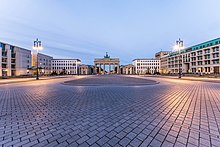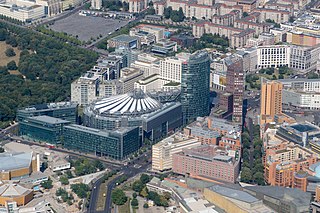
Potsdamer Platz is a public square and traffic intersection in the center of Berlin, Germany, lying about 1 km (1,100 yd) south of the Brandenburg Gate and the Reichstag, and close to the southeast corner of the Tiergarten park. It is named after the city of Potsdam, some 25 km (16 mi) to the south west, and marks the point where the old road from Potsdam passed through the city wall of Berlin at the Potsdam Gate. Initially, the open area near the city gate was used for military drills and parades. In the 19th into the 20th century, it developed from an intersection of suburban thoroughfares into the most bustling traffic intersection in Europe. The area was totally destroyed during World War II and then left desolate during the Cold War era when the Berlin Wall bisected its location. Since German reunification, Potsdamer Platz has been the site of major redevelopment projects.

The Brandenburg Gate is an 18th-century neoclassical monument in Berlin. One of the best-known landmarks of Germany, it was erected on the site of a former city gate that marked the start of the road from Berlin to Brandenburg an der Havel, the former capital of the Margraviate of Brandenburg. The current structure was built from 1788 to 1791 by orders of King Frederick William II of Prussia, based on designs by the royal architect Carl Gotthard Langhans. The bronze sculpture of the quadriga crowning the gate is a work by the sculptor Johann Gottfried Schadow.

Unter den Linden is a boulevard in the central Mitte district of Berlin, Germany. Running from the Spree River to the Brandenburg Gate, it is named after the linden trees that line the grassed pedestrian mall on the median and the two broad carriageways. The avenue links numerous Berlin sights, landmarks and rivers for sightseeing.

Mitte is the first and most central borough of Berlin. The borough consists of six sub-entities: Mitte proper, Gesundbrunnen, Hansaviertel, Moabit, Tiergarten and Wedding.

The Academy of Arts is a state arts institution in Berlin, Germany. The task of the Academy is to promote art, as well as to advise and support the states of Germany.
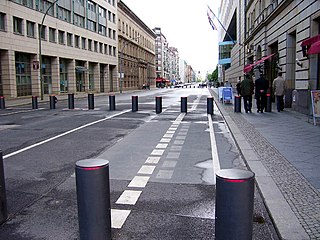
Wilhelmstrasse is a major thoroughfare in the central Mitte and Kreuzberg districts of Berlin, Germany. Until 1945, it was recognised as the centre of the government, first of the Kingdom of Prussia, later of the unified German Reich, housing in particular the Reich Chancellery and the Foreign Office. The street's name was thus also frequently used as a metonym for overall German governmental administration: much as the term "Whitehall" is often used to signify the British governmental administration as a whole. In English, "the Wilhelmstrasse" usually referred to the German Foreign Office.

The Hotel Adlon Kempinski Berlin is a luxury hotel in Berlin, Germany. It is on Unter den Linden, the main boulevard in the central Mitte district, at the corner with Pariser Platz, directly opposite the Brandenburg Gate.

Ebertstraße is a street in Berlin, the capital of Germany. It runs on a roughly north-south line from the Brandenburg Gate to Potsdamer Platz in the centre of the city.

The Embassy of the United States of America in Berlin is the diplomatic mission of the United States of America in the Federal Republic of Germany. It started in 1797, with the appointment of John Quincy Adams to Berlin, the capital of Prussia. There was no permanent building for the embassy until 1930, with the purchase of the Blücher Palace. During the United States involvement in World War II, the embassy ceased operations.

Berlin Brandenburger Tor station is an underground railway station in the central Mitte district of Berlin, Germany, located on the Unter den Linden boulevard near Hotel Adlon, Pariser Platz and Brandenburg Gate. It is served by the Berlin S-Bahn and U-Bahn, as well as local bus lines. The station was known as Berlin Unter den Linden from 1936–2009.
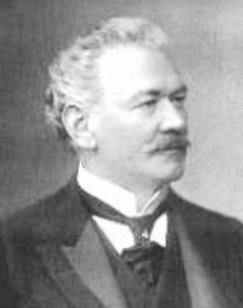
Lorenz Adlon was a German caterer, gastronomer and hotelier.

Leipziger Platz is an octagonal square in the center of Berlin. It is located along Leipziger Straße just east of and adjacent to the Potsdamer Platz.

Mitte is a central section of Berlin, Germany, in the eponymous borough of Mitte. Until 2001, it was itself an autonomous district.
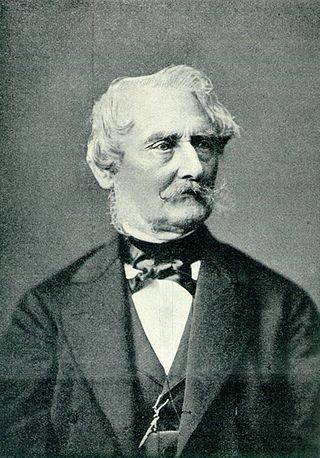
Johann Heinrich Strack was a German architect of the Schinkelschule. His notable works include the Berlin Victory Column.
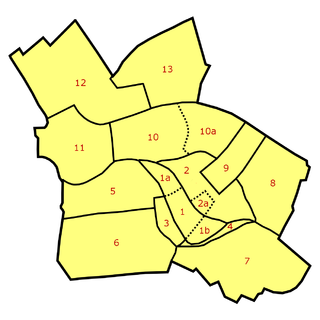
is a historic zone or neighbourhood (Stadtviertel) of central Berlin, Germany, which forms part of the locality (Ortsteil) of Mitte within the borough (Bezirk) also called Mitte. It contains several famous Berlin landmarks: the Brandenburg Gate, the Pariser Platz, and Unter den Linden.

Theodor-Heuss-Platz is a large city square in the Westend district of Berlin, Germany. It is named after Theodor Heuss (1884–1963), the first President of Germany after World War II.

The Embassy of France in Berlin is the diplomatic mission of the French Republic in Germany. Designed by Christian de Portzamparc and completed in 2002, it is at the same address, Pariser Platz 5, as the former embassy which was destroyed in World War II. Prior to German reunification, France had an embassy in the German Democratic Republic at a different address in Berlin and an embassy in the Federal Republic in Bonn.

The Old Palace, also called Kaiser Wilhelm Palace (Kaiser-Wilhelm-Palais), is a former royal Prussian residence on Unter den Linden boulevard in Mitte, the historic heart and city center of Berlin. It was built between 1834 and 1837 by order of Prince William of Prussia, who later became William I, German Emperor, according to plans by Carl Ferdinand Langhans in Neoclassical style. Damaged during the Allied bombing in World War II, the Old Palace was rebuilt from 1963 to 1964 as part of the Forum Fridericianum. Since then, the listed building has been home to the law faculty of the Humboldt-Universität.

Wolfgang Scheunemann was the first victim shot by the Volkspolizei (VP) at the sector border in Berlin. He was shot during a VP operation in Unter den Linden during the Berlin Blockade.
